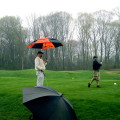
As you watch your short-iron approach shot drift to the right of the 18th green, your initial reaction is calm. After all, we’ve been taught as golfers to think positive. As the ball’s in flight, your mind chases away any concern by predicting you will have a short pitch to the dance floor and a nice one-putt to save par.
Alas, this is not the course you played last week. And where that 18th green welcomed you with short rough to its right flank, this one mocks you with a small pond. In an instant, your ball is wet, your hopes for par are dashed, and you’re hit with the realization that golf is not like other sports.
You see, unlike other sports, no two golf courses are exactly alike. Sure, baseball fences vary, but it’s still 90 feet to first base in every major league park. Football, basketball, hockey and soccer field dimensions are even more uniform, fitting exact specifications no matter where you are.
But in golf, the diameter of greens are never the same. Some are smaller, some are bigger and rarely are they perfectly round. Not to mention, the pin is never in the same position. Can you imagine if some football field end-zones were only 5 yards deep instead of 10? What if the goal post width varied – on some fields they would be 18’ 6” wide, while others would use college football widths (23’ 4”)? For fun, I’d like to see the NFL have their goal posts on hydraulics and move them around the end-zones at random during the game (sometimes you’d be kicking to the back, right corner of the end-zone to a goal post 20 feet wide, while other times you’d be kicking to the front left, with a goal post of 15 feet wide). Hey, that may increase the kicker’s reputation in the sport somewhat!
What about distances? In golf, you can have a 360-yard par 4 on one hole, and a 428-yard par 4 on the next. Par 3’s can be even more extreme. Believe me, when you’re an average hack like I am, there’s a huge difference between a 145-yard par 3, and a 205-yard par 3. Let’s apply that to basketball: It’s 13 feet from the free-throw line to the front of the rim. What if some courts adjusted that to 16 feet? Better yet, maybe some teams have great three-point shooters, so they decide to move the three-point line back a few steps – I’d say that’d cause a bit of a stir.
Hazards? Sand traps, reservoirs, trees, etc. Each golf course has its own challenges and aesthetics. Courses will feature an unimaginable amount of things to keep you from shooting low and, every course presents them in different layouts and styles. A shot you make one day with favorable results, can spell disaster the next day on different course.
Can you imagine if the NHL added a position player to each starting line-up just to go out there and check other players? These guys wouldn’t carry a stick, and wouldn’t be allowed to touch the puck – their sole job would be to slam dudes into the boards in an effort to disrupt the other team’s offense. OK, hockey may not be too far from actually implementing that rule, but this is what golfers face all the time (albeit minus the head trauma) – we hit what we think is a good shot and BAM! A bad kick and our ball careens off into the woods and out-of-bounds – instead of a missing tooth, we have a missing ball and a two-stoke penalty.
Baseball may come the closest – the pitcher must think about every pitch (like the golfer does for every shot). Just a slight flaw in mechanics can be met with disastrous results. And the pitcher has different batters he must navigate around (like golfers have to navigate different holes), and every one of them can be tamed, as long as he executes his pitch (similar to executing a golf shot).
But golf’s uniqueness remains steadfast. Only a very few number of athletes get to compete in professional baseball – most of us with an inkling to play-on are relegated to beer-league softball, where we no longer have to execute a pitch with such preciseness. But golf is unique. We golfers compete till late in life – long after our prime in other sports has passed.
Yet the strategizing, yardage calculations and other course management routines continue in our heads for every shot we take – no matter if we possess a scratch handicap or one above 30. It’s amazing, actually, for a sport to be dominated by players that aren’t very good at it, yet still take the game very seriously – and that, perhaps above all else, is why golf is one of the most unique sports in history.




Excellent analysis of why golf is so awesome. So often I’m asked “what can you possibly like about golf?” and I go to explain what it is and… I can’t. But you nailed it here. So I’m I’m printing this out and keeping a copy on me for the next time it happens. ;o)